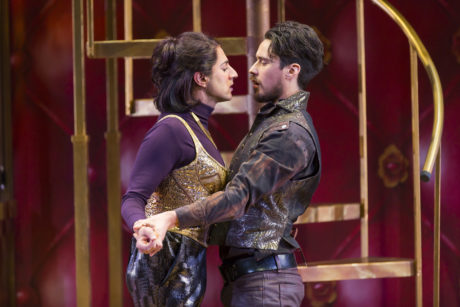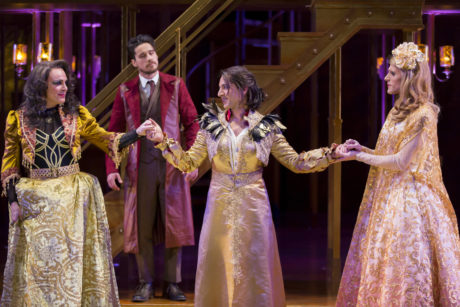Roman Holiday: The Taming of the Shrew at Shakespeare Theatre Company
According to scholar Jonathan Bate, “‘Shakespeare’ may be thought of as a vast collection of games…[some] games are resolved by games within the game—by cross-dressing and dressing up, disguising and playacting.” In Shakespeare Theatre Company’s (STC) The Taming of the Shrew, Ed Sylvanus Iskandar has accentuated the “let’s pretend” aspect of the play by using an all-male cast.

STC has initiated an innovative program to offer opportunities to young and emerging directors. The Clarice Smith Series: New Directors for the Classics gives these directors a chance to present Shakespeare in fresh and unusual ways. In selecting Shrew, Iskandar has made a provocative choice. Feminist critics have debated the play for years, as its misogyny is quite striking, though not perhaps unusual for Shakespeare’s time. The sheer outrageousness of Kate and Petruchio’s conduct can sometimes give pause: as 19th century critic William Hazlitt said, “It shows admirably how self-will is only to be got the better of by stronger will, and how one degree of ridiculous perversity is only to be driven out by another still greater.”
Iskandar’s style of “immersive theatre” encourages us to connect with the performers as well as the characters. In the lobby you will find the Piazza D’Amore, designed to resemble the open-air markets of Padua, where handmade goods, clothing, food, and gifts are available for sale. Aimed at a contemporary audience, it is an appealing entrée into the world of the play. As we enter, cast members in costume sing and welcome us. Rick Hammerly does an extremely effective turn as the Contessa (Shakespeare’s Widow) in a black and gold ensemble with bustier and high boots, suggesting the best of Renaissance and 1950s Italian fashion.
The production is set in an Italian dream-world, and as it opens a set, designed by Jason Sherwood, of luxurious beauty is revealed, with golden staircases, a blue patterned center, and echoes of Italian style then and now. Andre De Shields, as Gremio, the older suitor for Kate’s much-admired younger sister Bianca, blesses us all (he is now, mysteriously, a Cardinal); and then performs some distinctly modern dance moves. The stage explodes into motion as the entire cast performs “Tu Vuo Fa L’Americano,” a buoyant musical number. The costumes, by Loren Shaw, are spectacular; Bianca wears a pink dress with feathers and heels. Kate’s outfits are more somber, featuring pants and darker colors. Cast members ride bicycles, wear sunglasses, and generally behave like characters in Fellini’s La Dolce Vita, without the depression. Bianca (Oliver Thornton) performs her opening song with élan: entitled “On a High” it celebrates the joys of being a popular girl.
In keeping with the “fashion” motif, Baptista Minola (Bernard White), Kate’s father, is a wealthy couturier of the House of Minola. In a fine portrayal by White, he appears desperate to marry off his intemperate older daughter Kate (Maulik Pancholy) (one critic referred to her as “a storm in petticoats”) so he can auction off, that is ensure the future of, his sought-after younger daughter Bianca. As Kate, Maulik Pancholy gives an extraordinary performance. Furious, vindictive, and suddenly frighteningly vulnerable, his Kate is utterly believable as a woman who meticulously decides the price she will pay for safety and love, makes her compromise, and refuses to look back.

Oliver Thornton’s Bianca connects with her tempestuous older sister in some sweet, tender moments. The two embrace just before Katherine’s wedding, and there is a sense that despite their differences the two sisters love each other. Thornton’s Bianca is sensitive and very alert to the undercurrents of her experience. Because Thornton is male, the standard gestures of courtship (proffering a rose, for example) seem ritualistic and the role-playing aspect of love comes to the fore. Because men are playing women, there is a kind of Brechtian “alienation effect”- which seems counterintuitive to Iskandar’s stated purpose of connecting with the audience. Yet the cast’s enthusiasm and commitment keeps us engaged.

One of the glories of the evening is Tom Story’s Hortensio. A rich citizen with a crush on Bianca, he is alternately indignant, frustrated, and bamboozled; but he is always hilarious.
As Lucentio, Telly Leung is disarmingly earnest in his love for Bianca, although there also appears to be something going on between him and his tutor Tranio (expertly played by Matthew Russell).
Peter Gadiot is an exceptionally sympathetic Petruchio. There are some changes which soften his character; Kate is actually allowed to eat, for example; but he appears so reasonable in his unreasonableness that it is believable that she would capitulate to him. He and Pancholy make an intriguing pair of lovers.
Gregory Linington as Grumio, Petruchio’s servant, provides many comic moments, and his relationship with his master is richly detailed and convincing. It is a delight to see Andre De Shields on the STC stage. As well as the terpsichorean Cardinal, he is Vincentio, couturier and father of Lucentio, who is enraged to find, due to a twist of the plot, that he is introduced to himself. All the double (and sometimes triple) casting works well, from Andre De Shields’ Gremio/Vincentio/Curtis to Rick Hammerly’s Contessa/Pedant, to Bernard White’s Baptista/Tailor to Oliver Thornton’s Bianca/Haberdasher.
As Biondello, Drew Foster is especially effective in his signature speech, as he describes Petruchio’s unconventional wedding apparel. The Ensemble: James Crichton, Stephen Elrod, Jamison Foreman, Jackson Knight Pierce, Brian Reisman, and Nicholas Yenson, are all first-rate.
At the Intermission: An Intermezzo: Eros in Padua, the cast performs a kind of mini-opera, as the audience comes on stage to watch. The audience wandered around at leisure, going in and out, snapping pictures with their i-Phones, in a unique instance of the possibilities of the immersion technique (Craig Baldwin is Immersive Designer). Audience members seemed to enjoy greeting the cast in the lobby, being onstage, and participating more in the action, without feeling compelled or assaulted in any way. This theatre experience is anything but passive.
For traditionalists, it may be hard to erase from one’s mind, for example, the image of Elizabeth Taylor and Richard Burton battling it out in the 1967 movie. The combative Kate is like a sensual mezzo-soprano; all fire, all brimstone, and all woman. Petruchio, in this context, is the hyper-masculine bully who must show Kate a thing or two, and, unfortunately, attempt to turn her into a compliant wife. “You’re beautiful when you’re angry” comes to mind.
But it is heartening to see such an imaginative approach to Shakespeare. The creative team, Director Ed Sylvanus Iskandar, Costume Designer Loren Shaw, Scenic Designer Jason Sherwood, Lighting Designer Seth Reiser, Sound Designer Jeremy S. Bloom, Music Supervisor/Designer David Dabbon, and Choreographer Chase Brock, have created a visually and aurally opulent experience.
Music by Tony Award winner Duncan Sheik gives even minor characters the opportunity to share some of their inner life with the audience.
Iskandar and Literary Manager Drew Lichtenberg have muted some of the more sexist language (“girl” instead of “haggard”). Some plot elements have changed, and the songs open up the world of the characters. The music, though pleasing, was sometimes monochromatic and overly melancholy. Some of the humor was unnecessarily broad, and the production could benefit from some additional cuts. But this Shrew is nonetheless a thought-provoking take on one of Shakespeare’s most controversial plays.
The concept of gender fluidity is central. It is intimately connected with the idea of creativity itself. “Madame Bovary c’est moi!” said Gustave Flaubert. Could George Eliot or Edith Wharton conceive believable male characters? Was Proust tapping into a deeper reality when he turned Albert into Albertine? Obviously the answer is yes, in the case of these great writers. But this truth suggests a question: is there such a thing as a gendered imagination?

The advent of the trans movement has opened up our understanding of gender in new and uncommon ways. There is another gender category: “fluid.” Perhaps society is only now catching up to the idea that gender, which has always, in some sense, been constructed, is even more variable than we thought.
And then there is that final speech in which Kate submits, the bugaboo of actors and actresses throughout the centuries. There are many interpretations; the “wink” of course, used to great effect this year by Christine Sherrill in the Shakespeare Theatre Company’s glorious Kiss Me, Kate. There is the “Stockholm Syndrome” approach. And there is always “say the lines as written,” which reminds us of George Bernard Shaw’s famous quote: “No man with any decency of feeling can sit [the final act] out in the company of a woman without being extremely ashamed.” I don’t want to spoil the surprise, but Pancholy’s approach is deeply felt and beautifully acted. To some extent, however, the meaning still remains elusive.

Shakespeare Theatre Company deserves our support for taking risks and continuing to experiment. Shakespeare is so vital to our culture that new interpretations are not just desirable, they are essential. To the director, cast, and creative team, I can truly say: Molto bene.
Running Time: Approximately 3 hours, with one 30-minute intermission.
The Taming of the Shrew plays through June 26, 2016, at Shakespeare Theatre Company’s Sidney Harman Hall – 610 F Street, NW, in Washington, DC. For tickets, call the Shakespeare Theatre Company Box Office at (202) 547-1122, or purchase them online.
Note: STC has invited local artists, innovators and restaurateurs to lead a series of make-and-take workshops, life-hack seminars, tastings and demonstrations in STC lobbies during the run of the production. The workshop series, The Padua Finishing School, can serve as a standalone event or can accompany a ticket to The Taming of the Shrew. Fees range from $12-$100.
RATING:




